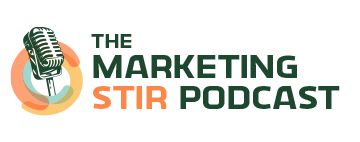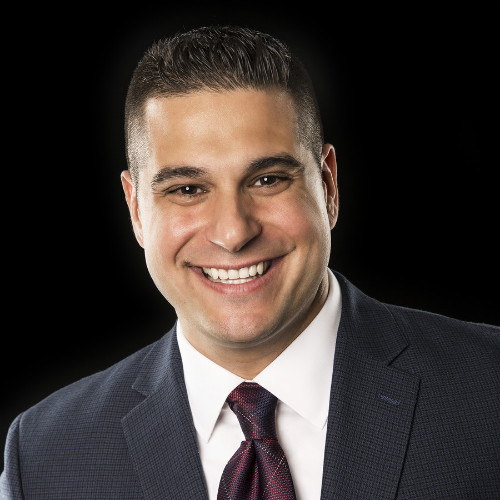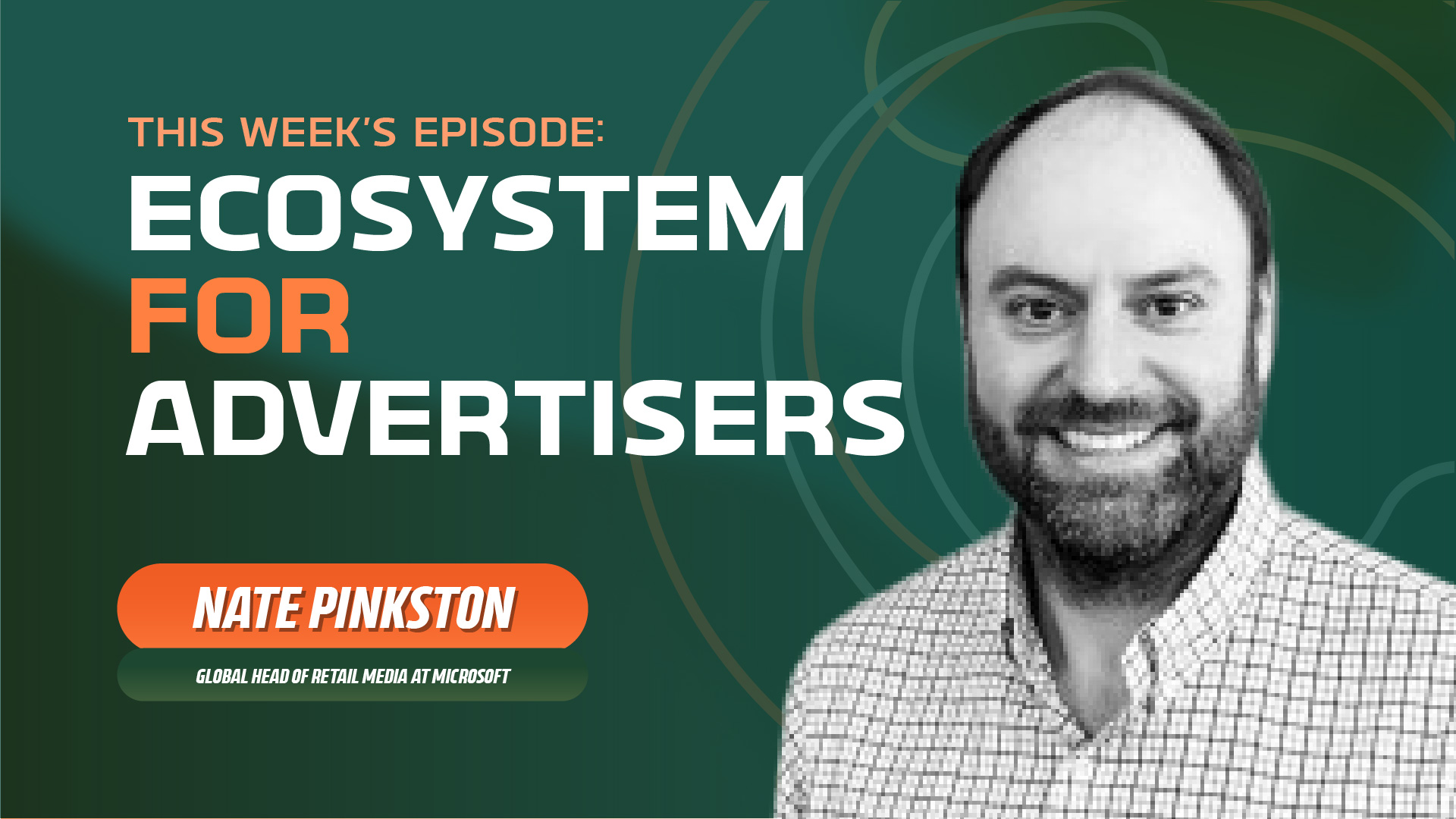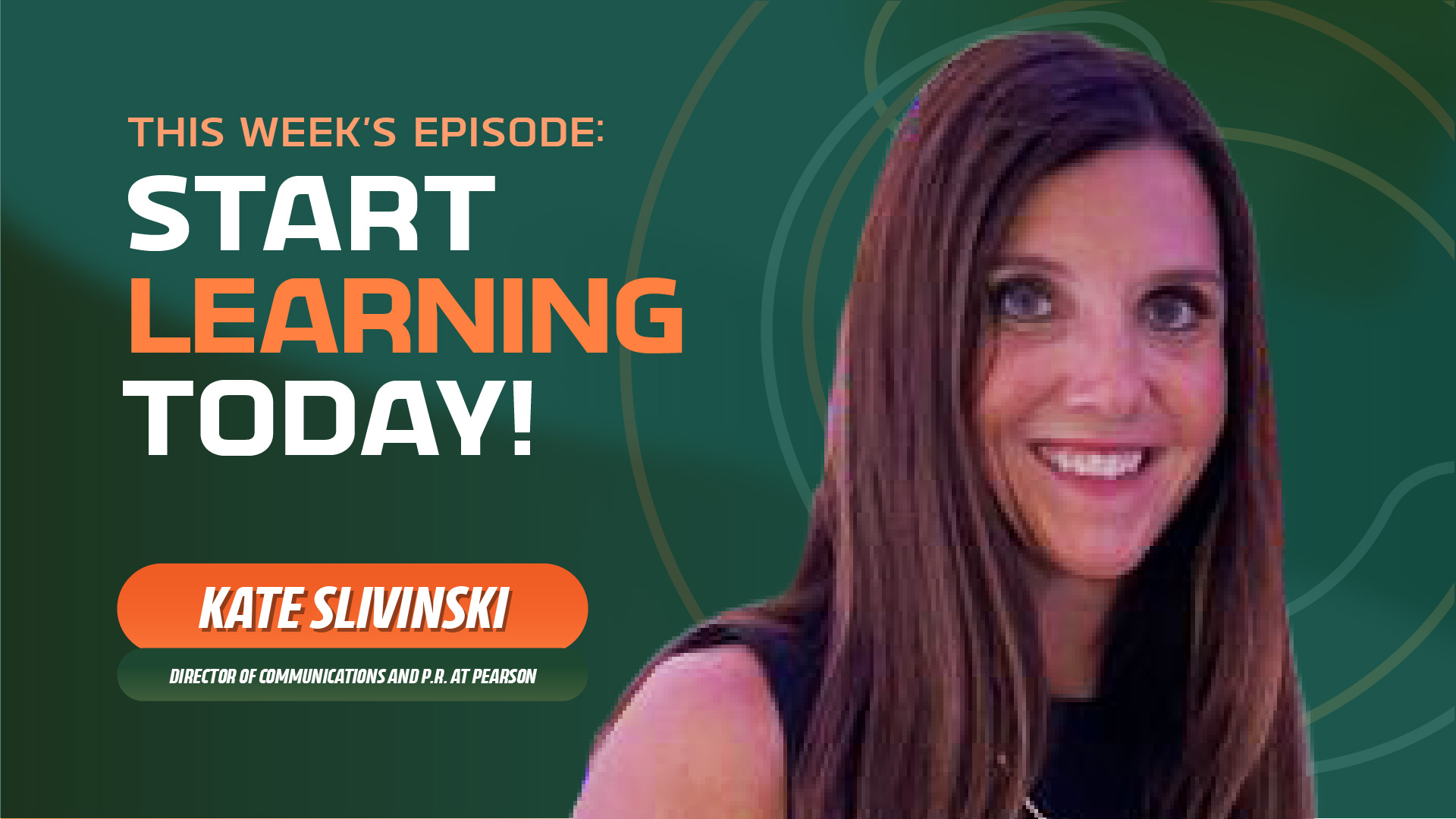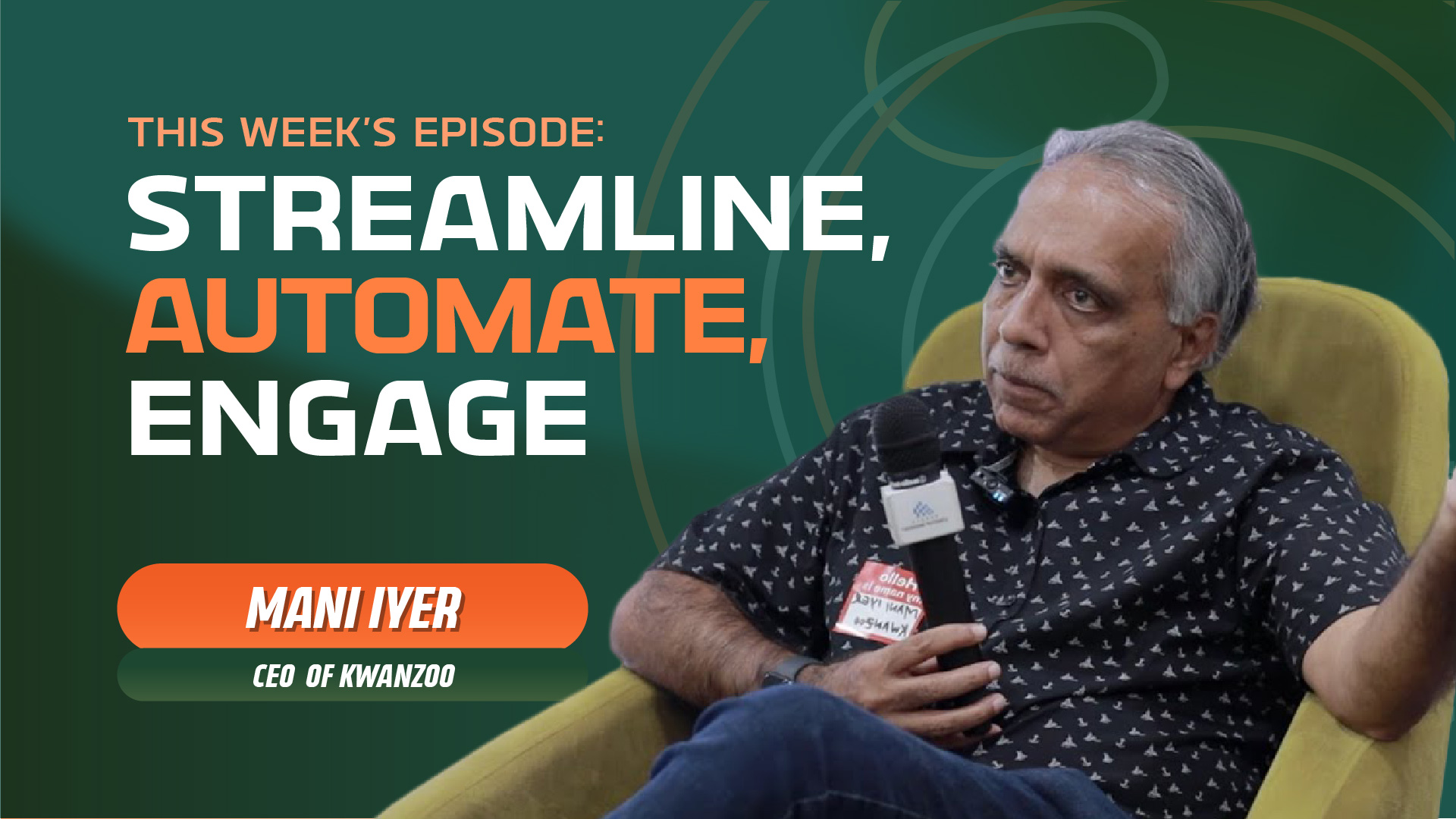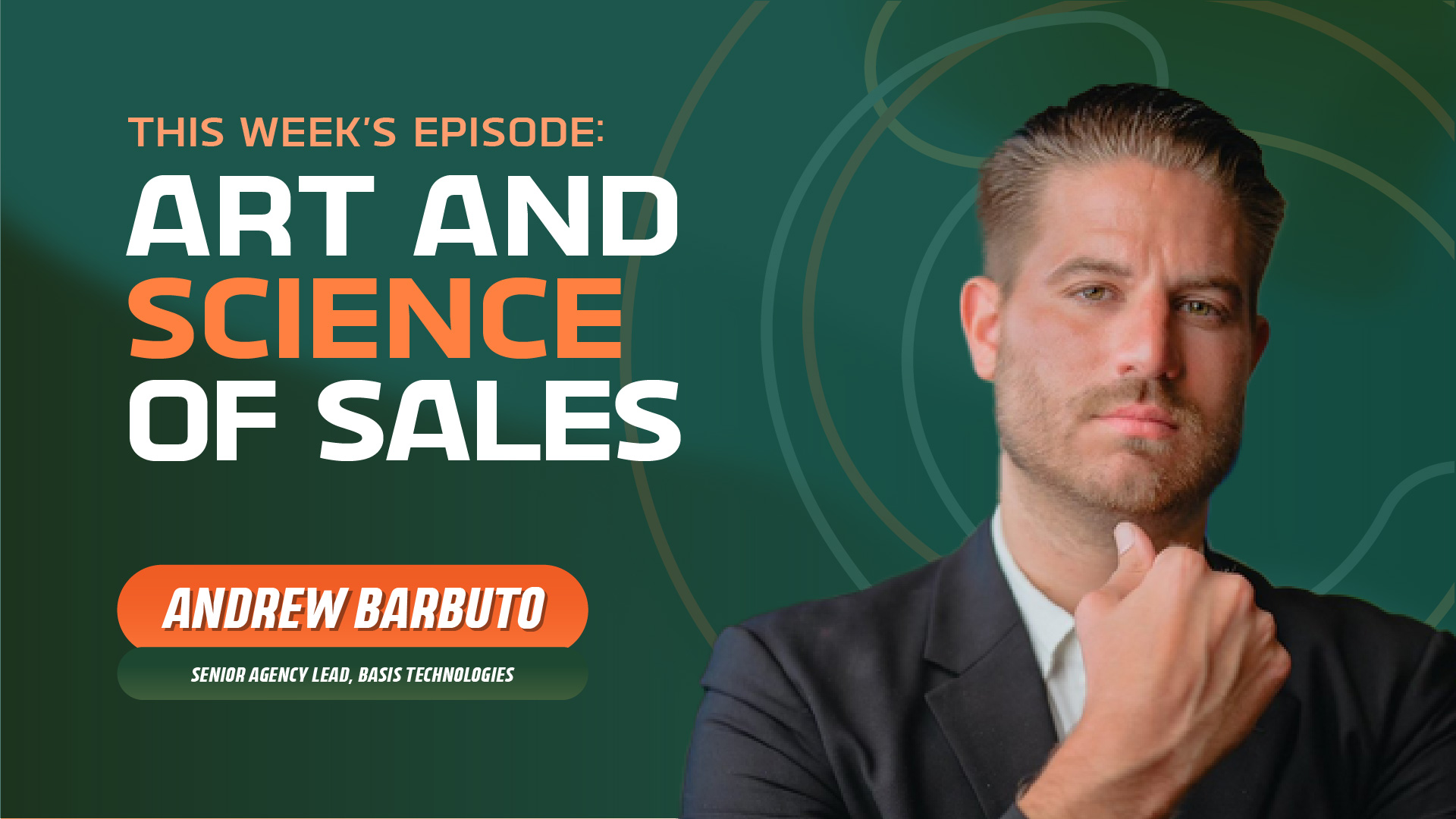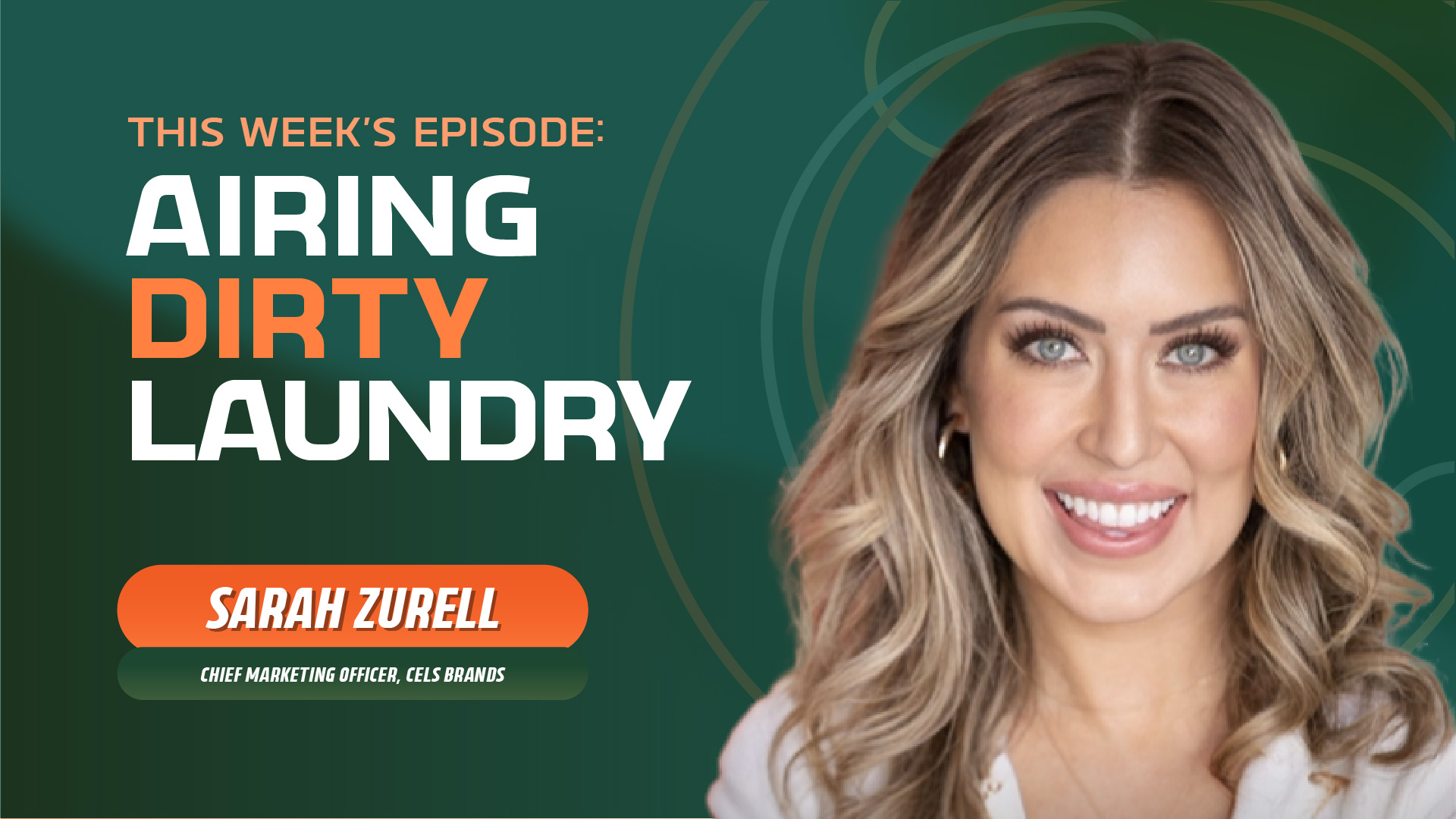Aaron Wollner (Quontic) - Little Clever Wink
- 0.5
- 1
- 1.25
- 1.5
- 1.75
- 2
Speaker 1: Maybe big data has gotten too big. Whether you're a B2B marketer or a consumer brand, your data needs to be viable, relevant, and accessible, so that Stirista can help you retain customers, acquire customers, and make it personal.
Vincent Pietrafesa: Welcome to The Marketing Stir podcast by Stirista, probably the most entertaining marketing podcast you're going to put in your ear. I'm Vin, the producer here at Stirista. The goal of this podcast is to chat with industry leaders and get their take on the current challenges of the market, and we'll have a little fun along the way. In today's episode, Aaron Wollner, the Chief Marketing Officer at Quontic, chats with us about how technology and user experience connects customer service reps with customers effectively. Give it a listen. Ladies and gentlemen, hello, hello. It is me, Vincent Pietrafesa. That must mean it is The Marketing Stir. Thank you for listening and thank you for all the amazing kind words that you're emailing us, that you are telling Ajay and I when you see us at conferences. What a nice treat when people come up to you and they're like, " Wait a minute. Hey, I listened to you while I'm working out." I'm like, " Well, that can't be that motivational, but whatever, sir, keep on listening. I appreciate it." But it's so good to be here. Thank you, ladies and gentlemen. Let's talk about Stirista for the first time you're ever listening to the podcast, The Marketing Stir stirring things up, Stirista. We're having a conversation. Let's pause and talk about Stirista just for like 14 seconds. Maybe it's more than that, but who are we? We are a marketing technology company. We own our own business to business data, business to consumer data. We help companies access that data and help them get new customers. New customers are fun. Who doesn't want new customers? We do that through our own email, sending our own DSP, connect the TV. Email me, vincent @ stirista. com. I of course am the Vice President of B2B Products and Partnerships. I only deal in B2B, but we do all of it. So, email me, I'll point you in the right direction. You are emailing me, which I do appreciate. Not all the time is it for what I intend, but it's okay. You're listening. Nine times out of 10, you're trying to sell me, but hey, do your thing, man. Do your thing. It's so good to see this next person. He is my CEO, our commander in chief here at Stirista. He claims that shirt's pink, but I think it's orange because he can't escape the orange. That's our colors, ladies and gentlemen. Mr. Ajay Gupta, what's up, Ajay?
Ajay Gupta: Hey, Vincent. Bright day here in Texas. I'm actually going to be headed this weekend to play a state tournament in Dallas, so we'll see a true test of human spirit when we're playing in 105 to 110 degrees.
Vincent Pietrafesa: I know, it's crazy. That's all I keep hearing in the news is all of down south, just that whole area is just record highs. I'm like, " That is awful. That is awful."
Ajay Gupta: Yeah, and I think Dallas is slightly hotter than San Antonio, so it's hard to imagine what hotter than San Antonio feels like, but we're about to find out in the next day or two.
Vincent Pietrafesa: That is crazy. I'm so glad you did not have anything there this summer. I remember we're going to have a little get the team together. We're like, " What? Are you nuts? It's August in San Antonio. No way. Let's save it to September," which isn't much different, I would imagine, but hey, I'm sure it's like three degrees cooler.
Ajay Gupta: I think you'll find the difference between 105 and 98 to be quite different.
Vincent Pietrafesa: Oh, I would imagine. If that happens in New York City, it's shut down. They shut New York City down. Everyone's opening up fire hydrants, which you could do apparently. I've seen that many a times in New York, and I'm sure our guest coming up has seen that having lived in New York before. Yeah, people ask me all the time, the question I get asked all the time about you, Ajay, is Ajay really good in tennis? I was like, " I don't know why. Are they judging you? What are they judging you for?" I was like, " No, he's good legitimately." It pains me to say something nice about him, especially athletic wise, but he's actually good in tennis. People follow tennis. US Opens coming up, so that should be a fun time of tennis. So, yeah, no, you are actually good. I was surprised.
Ajay Gupta: I think you told that ping- pong story so many times that people really started questioning my athletic abilities.
Vincent Pietrafesa: Yeah, they did. Well, I don't know how much athletic ability ping- pong takes, especially the type we're playing at a holiday party after a few beverages, ladies and gentlemen, but you got to see some people in the park here in New York City. I walked by these two people playing in the park. These guys are on fire. I'm like, " This is crazy." But yeah, I wasn't like that. Maybe it was beginner's luck, like your Fantasy Football season last year.
Ajay Gupta: Oh, all right, shots fired.
Vincent Pietrafesa: Shots fired, ladies and gentlemen, because the season's about to start. But enough about us. I will see you very soon in New York City and I hope to see this next guest in New York City one day. He's no longer here. He left, which I'm very upset about, but I knew when I talked to him and our producers know this and Ajay, you even know this. You're like, " How do you know someone used to live in New York? How do you know they used to be an East Coaster?" I feel it. It's in our bones and I'm sad that he's no longer here in New York, but we are going to get together, ladies and gentlemen. I'm very excited for you to talk to this company, Quontic. It's a very unique company. I love the concept. I think the world needs this right now. Ladies and gentlemen, he's the Chief Marketing Officer of Quontic. Ladies and gentlemen, Aaron Wollner. What's going on, Aaron?
Aaron Wollner: Hey, Vincent, how are you?
Vincent Pietrafesa: Doing great. Doing great. Awesome to talk to you again. Yes. Why did you leave New York? That's not one of the questions. I was like, " Why did you leave New York City?"
Aaron Wollner: I guess I'm a follower, right? So mid- pandemic, there really was this bizarre exodus I think that things got all shuffled and you lost perspective because one thing every New Yorker shares is the love for their neighborhood. You love Tribeca, that's your neighborhood, and there's a relationship there. So, my last stop for the last five years was Carroll Gardens in Brooklyn.
Vincent Pietrafesa: Love it.
Aaron Wollner: I had this deep connection to my immediate area, which changed so much. We don't need to rehash all the closings and the bizarre stuff that was happening at that time, but yeah, so all of that definitely affected my wife and I. We just found it to be the right time to pick up the family and move down south a little bit to where we're from. So, we're currently in the Baltimore area. We both visit New York City regularly. Our offices are there and we missed it, but it's less like of a daily missing. It's more like, " Hey, that was a hell of a time."
Vincent Pietrafesa: That's awesome. Then you have ties to that area. Like you said, you're originally from where you are now. So, I get it. A lot of people don't realize, Aaron, and these are not my official questions I want to ask. I'll get to those in a moment, but a lot of people don't realize that when you're in New York City, there are neighborhoods and it's rare that I go outside of the neighborhood, believe it or not. When someone now is like, " Oh, let's meet in Times Square," I'm like, " Oh, really? Times Square, are you crazy?" But anyway, well, we're glad that you'll be coming back to visit and we'll definitely get together. But Aaron, let's get into it here. Quontic, for the people listening, tell us about Quontic. Obviously, the CMO role, generally, people know what that entails, but tell us, sometimes there's different nuances, so Quontic and what your role specifically involves there.
Aaron Wollner: Yeah, so we're a digital bank. So, we're a financial institution that exists completely online. That's the very basic definition. What sets us apart, I think that's my job and some of the branding that I've worked on. I just passed my three- year mark at Quontic, so nice little milestone for me personally. A lot of my team that I brought in over the past couple of years have certainly helped a lot with this. But from a brand standpoint, what sets us apart is that we are a digital bank with a heart. That needs to mean something. That sounds nice, but where we landed was we have to acknowledge and accept the trade- off. If you're going fully digital and you're fully online, you're by definition less human. Especially given where we are, we were just talking about the pandemic, I do think that at the end of the day, connection matters, good human customer service matters. You see this all over the place across different industries. Customer service being emphasized, brought back stateside, and that real emphasis on just amazing customer service and how that creates a long- term business model. So, all of that to say is that we acknowledge that and where that brought us to was a more humane place for the digital bank. So, we do have all sorts of new and interesting ways for you to interact with our people. So, we have the digital bank side of the business, we have the mortgage lending side of the business, and there are some pretty cool differentiating things from both of those sides. From the digital bank side, we are innovative and we could talk a little bit more about that. I'm sure it'll come up in different examples, but we put pressure on ourselves to innovate, come up with new stuff, experiment, and I think that sets us apart. Then on the mortgage side, we are CDFI, which is another acronym. We're acronyms all over the place, but community development and financial institution. So, we actually have a mandate to help people to led to the underbanked, the underserved. There's a lot that goes into that and I can go into more of that definition, but there is that humane aspect in terms of who we're lending to. It's a lot of the time what other big financial institutions won't do. We found a really good risk averse way to figure that out. So, a lot goes into it, but at the end of the day, we are a best in class digital bank with a heart.
Vincent Pietrafesa: I love that. We do have a lot of questions around digital banking, the differentiators, why you think people are doing it. We'll get to that in a moment, but there's a few questions that if we don't ask our staple questions, boy, do our listeners get angry. So, let's take it to that. Second question I have for you is how did you get started in marketing? People love hearing this story, because 9 times out of 10, it's like I was a religion major and here I am doing marketing. I'd love to hear your story.
Aaron Wollner: Yeah, it's like, " Oops," right? I think every CMO is like, " Oops, here I am." So similar story, I was a political science major, business minor. I flipped those two. Initially, I was a business major, but I don't know if you went to business school or anything. Studying business, it's a weird thing to study, because it's such a practical practice thing that when you're in it, that's where you learn all your hard knocks and your lessons and you gain all that experience. Studying the basic principles of marketing, it's just fundamentals and it's made up words for very practical things that we inherently know anyway. But all that to say, yeah, I accidentally fell into it. My first job out of school about 17 years ago was with this really amazing MarTech startup by the name of Optimo. So, we were first to market with multi- variate testing. So, every marketer worth the salt is doing some form of testing and experimentation, maybe testing webpages, products. We're testing and measuring and that's just an accepted approach for marketers across the board. But we were first to market with the technology that allowed websites in 2006 and 2007, 2008 before we got acquired a couple of times, which was its own interesting journey, to break down webpages into individual parts and to test them through regression analysis and applying advanced statistics. That's really what set me along my path, because what I found there was the marriage between hard numbers and the measurability of marketing. Up until that point, marketing was fluff. I really saw it as the fluffy stuff. So, that's when I fell in love with marketing and the harder side of marketing and what it really means to a business. So, off I went, I joined Sapient, which is now Publicis, shortly thereafter, spent a number of years on the agency side working on mostly big projects for big businesses. That's where I cut my teeth and got serious about all the rigors of managing a big project and the marketing fundamentals and helping big companies figure out complex problems really from the consulting angle. Then I found my way into more FinTechs, because most of my clients from the beginning just ended up being financial institutions, Bank of America, American Express, Citi National Bank. So, this was a natural progression. Eventually, I joined a FinTech as the head of marketing and found my way to Quontic a number of years ago. So, yeah, I mean specializing in marketing, the common thread throughout really being data analytics and trying to be the master of marketing from that numbers angle, even when it comes to the fluffy stuff, even when it comes to the brand side. So, that's who I am as a marketer. My journey was not a straight one. A lot of zigs, a lot of zags, and I think I'd love to hear that 1 out of 10 you alluded to who was like, " Yes, out the gate, as a young man or a young woman, my ambition was to be a CMO." Yeah, I'd like to talk to that person.
Ajay Gupta: Awesome, Aaron. Hey, I know you guys are digital bank, so we're curious whether that lends itself to digital marketing being the primary channel or are there strategies you guys use to market as well?
Aaron Wollner: Primarily digital, which you would assume, but actually, this is a recent story. So, last week, a few folks on my team went down to Orlando. There was the big Florida Mortgage Convention. So, we went down to support sales and really more from a research standpoint. We got together, and this also blends into the fact that we're all remote. So, I try and find good meaningful spots for some people on my team to get together. So, anyway, all this stuff came together. One of the things that we did outside of anything mortgage convention related was we packaged up 500 mailers ourselves and we did a little campaign. We did a physical mailer, and the insert basically was nice fun copy about the only thing you'll miss from traditional banking is the lollipops that you used to get from the desk. I think we can all remember that experience as kids. We actually dropped five Dum- Dums lollipops with this nice message, this little clever wink, which is a part of our brand. We're constantly trying to find these nice little moments to just wink at our customers in a fun way. So, actually, there was clearly a marketing goal there. So, we pinpointed our 500 lowest balance, high yield savings customers, and we mailed them this fun little thing. There was no QR code to yay, increase your deposit now or our high savings is up to 4. 5%, which is top of market. We didn't do any of that. This really was a delight, feel good, physical moment where we wanted to touch a small subset of our customers. So, that's an example of non- digital, but the lion's share by and large, where we're spending money, where we're spending time is completely digital.
Ajay Gupta: Aaron, has the marketing strategy itself changed because of some of the economic changes that are happening at a macro level in the banking industry?
Aaron Wollner: Yes but not as much as I feared. Fear is the operative word. A potential run on the bank is a very scary thing. So, in Q1, we all know about SDB and the handful of banks that essentially went under and there really was a literal run on the bank. Each had its individual dynamics and thank goodness it didn't spread. But I remember coming back from a meeting and I'm just in an Uber and the driver was listening to talk radio, basically talk about how they're stuffing cash under their mattress. So, CMO of a bank, I'm hearing this stuff and just feeling this stuff and thinking, " Oh, my goodness. How much is this going to spread? How much fear of banking is going to spread and really change things and therefore change the way we market and communicate to customers and prospective customers?" So the truth is we adjusted a little bit. Thankfully, that didn't impact us directly. I mean, we saw a downward blip, but it wasn't anything significant in terms of losing a big chunk of customers. We actually benefited from it a little bit because I do think that it was the more regional banks that were directly affected. So, it's this interesting dynamic of if you've got regional banks in the middle and then on the other side you've got the massive financial institutions, Citi, Bank of America, and so on, then on the other side of the spectrum is the more nimble digital FinTech type banks. So, I think it spread a little bit from the middle, and we actually benefited from that a little bit. I think there was an increase. We saw it in search and just how active people were in terms of moving money after that happened. So, we ended up benefiting from that a bit, which is really interesting, but the short answer to your question is yes, I think we changed our tone a little bit. I've mentioned that part of our brand is to try and bring some joy and find those moments to wink and celebrate a little bit. We're doing that less, because I think there's a little bit more of a serious time from a macroeconomic standpoint, but thankfully not all that much has changed. I think that if you asked me four months ago, I would've been way more scared. Our tone did change pretty dramatically for a period there, but I think we're back to trying to be ourselves and recapture our brand voice.
Ajay Gupta: Aaron, the first thing that I think of with digital banking is, all right, well, where do I find an ATM? What do I do there? What happens? I'm sure that's common. So, address that piece of it. Also, is Quontic not only personal banking, but is it mortgage loans as well? Talk to me all about that.
Aaron Wollner: Yeah, so we do have a network. Obviously, these are not Quontic branded ATMs. That wouldn't make much business sense, but we have a network actually of 90, 000 ATMs across the country. So, more or less, wherever you may be, it's not difficult to take out cash. Now, is it as easy as Bank of America? No, but that's not the game we're playing. But we do want to make sure that it's accessible and that part of banking, that the cash exchange part of banking through ATMs is not problematic. So, we figured that piece out we feel like just through our network of 90, 000 ATMs across the country. But at the same time, how many financial apps do you have on your phone, for example? More than one?
Vincent Pietrafesa: Yeah, about two, maybe one and one for sure. Maybe two.
Aaron Wollner: Well, I think two is on the low end. I've got seven or eight. I think the average person has a few, which means that people are not having that one- to- one banking relationship. So, we benefit from that. In fact, I've run campaigns with my team directly hitting on that. So, we did a little experiment through a few more social type channels about being your side bank, just like having a side relationship. It's okay, we get it. We're not trying to be your main squeeze, just try us out. Open up a high yield savings account, open up any different checking account. We offer a Bitcoin rewards checking account, which is pretty amazing. So, yeah, I think that really depends on your perspective, but I think strategically for me, what I've learned over the years is if you could find the right way to turn a weakness into a strength, that can really set you on a path to success. So, for me, I try to use that notion that I have to have this big sprawling financial institution that I can trust. If I'm going to be on a road trip through Kentucky, I'm not going to think twice about it. Again, that's basically true for us as well, but we leaned into that a little bit. We leaned into the fact that you may not think about a digital bank as having that coverage or trust. Yeah, so we actually found some success from a messaging standpoint with that too.
Vincent Pietrafesa: That's awesome. Like you said, in regular banking, I couldn't tell you the last time I talked to a teller, right? When's the last time you go in and you talked to a teller? But I'm sure people still want that some personal touch, whether it's a customer service rep or being able to talk to someone. How does Quontic combat that? How do you lean into that?
Aaron Wollner: Totally. Yeah. So, technology plays a role and I think user experience, which is more the area that my team can directly help with. So, we've partner up with a company called Glia, which happens to be specifically for financial institutions, but it's a video chat tool. There's lots of different functionality and components to it, but basically, we want to make sure that you can see and interact with Quontic. It's not a robot. Yes, a robot may be involved in the initial touchpoint or not. That's up to you and based on the experience, but that partnership really helped solve that problem. Because it's one thing to say that, " Hey, bank human, bank Quontic," but show me that. Where is that? Can you interact with a human? So we saw for that through, if you go to our Contact Us page, you can interact with that tool on the bottom right. You can see our customer service reps. You can co- browse. You can hang out if you want, but we do have a small but mighty team of real people who care, who are great. That part of the business has really been a focus for the past couple of years. The other thing is bringing that to life. So, again, these are all web pages. If everything's digital, it needs to have this practical element to it. If you go to the Contact Us page, we need to show you that. So, the first thing you'll see when you load up the Contact Us page is a rotating video of real customer service reps waving at you that you're likely to see if you click into the Glia tool. So, my team helps solve that with the customer service team. I think, again, that's a good example of it's one thing to say it, it's another thing to do it, improve in it. I think for us, we were able to actually figure that piece out.
Ajay Gupta: You've worked at a number of startups and high growth type companies. What advice do you have for people that are trying to build up marketing teams and high growth companies?
Aaron Wollner: It's really hard. I wish it weren't as hard as it is. So, the big thing that I learned is the tension between the need for short- term, immediate big growth, that traditional hockey stick that every startup, they have a chart that says, " Hey, here's what we can do," and then go do it. Then a lot of that falls on the marketing team or the head of marketing, whoever that is, versus the long- term health and longer term metrics. I think most startups, it's funny what becomes trendy or popular. Metrics are trendy, actually, if you step back and think about what metrics we all care about or traditional startup cares about. This whole LTV: CAC business, it's been around for five plus years. Everyone's obsessed with it. That might not be the metric for you in that moment at that time. So, I think the biggest piece of advice I could give is don't just accept the common metric, the stylish trendy metric that you were handed. Challenge that, know that there are different paths to growth. There's a difference between pursuing volume versus quality, the business model, and where it's at in its maturity. If you're early stage, maybe you do care about just true conversion and not longer term LTV type metrics, because you know what? A lot of LTV math that a lot of businesses have, it's just funny math, right? It's a lot of assumptions baked into this model that may or may not be fully true. So, yeah, I think it's super hard. But being choosy, one of the things that I try and teach my teams is what we choose from a metric standpoint, be it a campaign or just a broader strategy. That's where the skill is, right? I think that that really is a skillset to know and have an intuition about what metric and what goal to pursue. Given the situation for early stage startups, it could be really tough.
Ajay Gupta: In terms of Quontic business in particular, was there something that drew you into the company when you first started?
Aaron Wollner: Totally. Yeah, I think it actually had a really great story. I think that people at the end of the day connect with a narrative and then the Quontic story starting as this sleepy, humble community bank outside of New York City and becoming this national digital bank with this very human side to it, helping people, giving back, doing good, I just love the story. So, the story was a big piece of it. I felt like as a CMO, there's a lot that I can do with that that was baked in, because a lot of times, you really struggle to create a brand. I don't know. How would you define a brand is a good question to ask anybody. How would you guys define a brand?
Vincent Pietrafesa: Oh, go ahead, Ajay.
Ajay Gupta: No, go ahead.
Vincent Pietrafesa: I would say a brand is anything that has a partnership or connection with their customers. A brand is anything that you are selling or your messaging, your persona. I tie those words in with a brand. How about you, Ajay?
Ajay Gupta: It's the sum total of how the world views you. So, I've always said being friend from the services and solutions side, if we were to sell T- shirts, you would probably get more respect as a brand than a solutions provider walking down the floor.
Aaron Wollner: So the reason why I love those answers is because it shows that really you could answer it in any-
Ajay Gupta: Different ways.
Aaron Wollner: ... thebrand is. So, Vincent, you had that more micro approach. You were describing the individual components that are a part of a brand. Then Ajay, you talked about the sum total, and I'm more of a big picture person. I love details too, but I think at the end of the day, when you think about a brand, it is macro and of course underneath the hood are all those things you talked about, Vincent, but the sum total of those things is I would argue a feeling, right? So what's your favorite tennis brand, Ajay?
Ajay Gupta: I use the Babolat brackets.
Aaron Wollner: People love Babolat, right? Yeah. So, yeah, I mean any relationship that you have with a brand, I think there's some connection and some feeling to it, but it's the sum total. So, did that tennis company do one thing that resulted in its brand? Probably not. Almost definitely not, but all the things put together and all their initiatives and tactics and promotions and sponsorships and the product itself, of course. So, I love these sorts of conversations, but from a brand standpoint and from a story standpoint, Quontic really attracted me. Then of course, the second part of this answer is going to be much quicker, the people. I think at the end of the day, what keeps people in their job if you were to drill down and what is the number one thing that keeps people in their job? It's people. It's the other people that they work with, and there's a lot that comes out of that. I feel like I'm being micromanaged or I have no control. All those negative things that come with surrounding yourself with maybe not the right people at work that might force you to look for something else. At the end of the day, it is all about the people. We've got a great leadership team and a great group here.
Vincent Pietrafesa: I love being asked questions. It's not often we get asked questions, and you're right. I once heard a statement where they're like, " No, your brand?" It's like, " Oh, this is my brand." It's like, " No, your brand is how people perceive you." So it's like people make your brand. That's how they see it. I like that question because you're right. It's like two people, just different answers. That's how you think about it. Let's stay on brand here. In the sense you mentioned in the beginning New York City, it was almost a regional bank, if you will, and then you started scaling nationwide. What was that process like? What did you find? What were some of the challenges, Aaron?
Aaron Wollner: Yeah, it was fast and furious. So, obviously, there's the compliance piece and we had to grow our legal counsel. So, there was real practical backend stuff that we needed to do to get that national charter. But once we had that in place, it was actually going out and proving to ourselves that we could. From a bank perspective, it's more straightforward because once you have that national charter and especially if you're online, if someone applies online for a checking product from Montana, we now have a customer in Montana, so there's not much to that. However, with the mortgage lending side, it really is more complicated because you need to have people selling in those areas. So, it was more challenging from a mortgage standpoint, but it actually happened quite quickly once we got all the pieces in place.
Vincent Pietrafesa: Aaron, one of our staple questions here on Marketing Stir has to do around LinkedIn. I'm sure with the places you've worked and the titles you've held, you get a number of unsolicited messages on LinkedIn. So, would love to know what's a message that gets a response from you and what's one that really annoys you?
Aaron Wollner: Yeah, they're mostly annoying, aren't they? So let's start there. So, I like to assume people are smart. I think this is just very broad philosophy. Do you assume people are smart or not? I think tricking people is really undercutting that optimistic philosophy. So, anyway, all of that to say, I can tell if you're tricking me. A message where the subject line might say like, " Hey, following up," or even" Go, Terps!" I went to University of Maryland, the Maryland Terrapins, and that's not even necessarily tricking. That's just more of obviously an approach and insinuates you know me, you know my background. So, yeah, I think more often than not, it can be perceived as, " Do you think you're actually getting one over on me?" or even pretending like they found an issue with something or that it's an existing relationship. All that stuff doesn't work in my opinion. So, assume positive intent, assume people are smart. Look, starting a conversation is never easy. I think that over the past few years where LinkedIn really has become incredibly popular and therefore it's brought in all this mass marketing and all this outreach that we see today, it's hard. I think it's really hard to cut through the clutter. I'm trying to think about what cuts through is a real offer. Actually, I think this may have originated on LinkedIn, if I'm not mistaken. So, yeah, I think if you've got a real proposition, if you've got a real conversation, if you've got a real value drop, it's never easy because A, you're cutting through the clutter. Yeah, so expect to be ignored, I think largely speaking, but don't try and trick people.
Vincent Pietrafesa: I like that. It's like you assume people are smart, but I also feel like a lot of the things that are sent are bots that it's, " Hello, Aaron. You work at Quontic Incorporated." I'm like, " Come on. Who says incorporated? No one says that." I think, yeah, it's one of those things you got to have to be careful. But yeah, it's funny, after 140, 145 of these, there's never been a marketing professional on the podcast who's been like, " Just send me 17 messages and make them very impersonal." But yeah, certain things have to stick. So, Aaron, we're getting to the end of the podcast here. Personally, let's get to know you personally. What do you like doing on the weekends? You have the family there, some hobbies. What do you like doing? Who do you root for sports wise? I'm wondering, you've been in New York a long time, but you're from that area. Is it the DC teams? Is it the Baltimore teams? Talk to us.
Aaron Wollner: Yeah, I'm hometown. So, I grew up in the DC, Maryland area, so it's those teams. There's some overlap with Baltimore because the Washington Nationals didn't exist when I was coming up. Currently, my wife and I and child live in the Baltimore area, and so it's cool to have that home team back but actually be 15 minutes from the stadium. So, I've gone to a bunch of games. Yeah, hobbies, last night I played hockey, so I play hockey twice a week. I'm on two different ice hockey teams. I keep that up. Every year that goes by that I'm still playing and competing... I think Ajay, you can relate. It's like, " Thank goodness that I'm still..." I don't know, I'm feeling really thankful these days that I can still go out there and compete and be productive and play a physical game. I think with age, you just get more appreciation with that stuff. So, yeah, I mean between the family and my wife has three siblings in the area. For example, we covered for my brother and sister- in- law. We had their kids at our house for a couple of days. So, there's always family stuff going on. I love barbecuing and grilling and hosting and exploring the city. We split our time weekend trips. We had to go into the city, just check out restaurants and stuff in Baltimore, or there's a bunch of farms and breweries and wineries 20, 30, 40 minutes away as well. So, love taking little road trips, love hopping on my bike. I miss biking. I bike rarely, but in New York City, I was on my bike basically daily. So, as a fairly new suburbanite, I'm reorienting and refining some of these hobbies also.
Vincent Pietrafesa: Yeah, that's amazing because like you said, the Chesapeake Bay, there's all these different areas there where you think Baltimore, you think like that downtown area with Phillips. What's that, a little harbor? But yeah, there's so many great things about the breweries. That's awesome. I love that stadium, my goodness, where the Orioles play. Beautiful. Probably one of the nicest stadiums. I remember going to a game there and my hotel room could see right into the stadium. It was pretty unique, but that's amazing. Aaron, we appreciate you sharing your story with us. Ladies and gentlemen, check out Quontic out there. If you're banking, you're looking to get away from the traditional guy or like you said, a second option there, but really look into them. That's Aaron Wollner, ladies and gentlemen, the Chief Marketing Officer at Quontic. This has been another episode of The Marketing Stir. That's Ajay. I'm Vincent. Let's hope Team Stirista wins in Dallas, ladies and gentlemen. Have a great day.
Speaker 5: Thanks for listening to The Marketing Stir podcast by Stirista. Please like, rate, and subscribe. If you're interested in being a guest on the podcast, please email us at themarketingstir@ stirista. com and thanks for listening.
DESCRIPTION
Aaron Wollner, the Chief Marketing Officer at Quontic, chats with us about how technology and user experience connects customer service reps with customers effectively.
